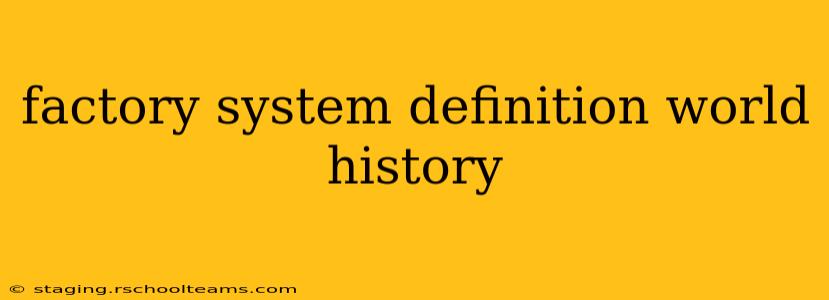The factory system, a cornerstone of the Industrial Revolution, irrevocably altered the course of world history. Its impact extends far beyond the mere production of goods, shaping social structures, political landscapes, and the very fabric of modern life. This article delves into the definition, evolution, and enduring legacy of this transformative system.
Defining the Factory System
At its core, the factory system represents a shift from decentralized, home-based production (like the cottage industry) to a centralized, mechanized system of manufacturing. This shift involved several key elements:
- Centralized Production: Workers congregated in a single location—the factory—to perform specific tasks in a coordinated process. This contrasts sharply with previous methods where individuals or families worked independently.
- Mechanization: Machines replaced or augmented human labor, significantly increasing productivity and output. This reliance on machinery demanded new skills and a different labor structure.
- Division of Labor: Production processes were broken down into smaller, specialized tasks, with each worker focusing on a single step. This specialization, though initially boosting efficiency, also led to repetitive and often monotonous work.
- Wage Labor: Workers were employed for wages, becoming dependent on factory owners for their livelihood. This created a new dynamic between employers and employees, fostering both innovation and exploitation.
- Mass Production: The combination of these factors enabled the mass production of goods, leading to lower prices and increased availability, but also contributing to issues like overproduction and market fluctuations.
The Evolution of the Factory System
The emergence of the factory system wasn't a sudden event but rather a gradual process driven by technological advancements and evolving economic conditions. Key stages in its development include:
Early Factories (18th Century):
Early factories were often powered by water wheels or steam engines, focusing on industries like textiles and mining. These initial ventures laid the groundwork for more complex and larger-scale operations.
The Rise of Mass Production (19th Century):
The 19th century witnessed an explosion in factory growth and the refinement of mass production techniques. The invention of the cotton gin, the power loom, and improved steam engines fueled the expansion of textile factories, while innovations in iron and steel production propelled the growth of heavy industry.
The 20th and 21st Centuries:
The 20th and 21st centuries have seen the factory system evolve further, incorporating automation, robotics, and sophisticated information technology. Globalization has also played a major role, with manufacturing shifting across national borders in search of lower labor costs and favorable economic conditions.
The Social and Political Impact
The factory system's impact extended far beyond the realm of economics. It profoundly reshaped society, leading to:
Urbanization:
Factories drew workers from rural areas to urban centers, creating rapidly growing cities characterized by overcrowding, poor sanitation, and social unrest.
Class Conflict:
The factory system exacerbated class divisions, creating a distinct working class often subject to harsh working conditions and low wages. This disparity fueled labor movements and calls for social reform.
Technological Advancement:
While initially creating challenging working conditions, the factory system also fostered technological innovation and advancements that continue to shape our world today.
Global Trade:
The mass production enabled by the factory system revolutionized global trade, fostering interconnectedness between nations and contributing to the rise of global capitalism.
Conclusion: A Lasting Legacy
The factory system, despite its inherent complexities and challenges, remains a defining feature of modern civilization. Understanding its history, its evolution, and its enduring impact is crucial to comprehending the world we inhabit today. Its legacy continues to shape debates on economic development, social justice, and the future of work. The ongoing evolution of the factory system, now incorporating automation and AI, promises further transformations in the years to come, demanding continued analysis and critical assessment of its societal effects.
